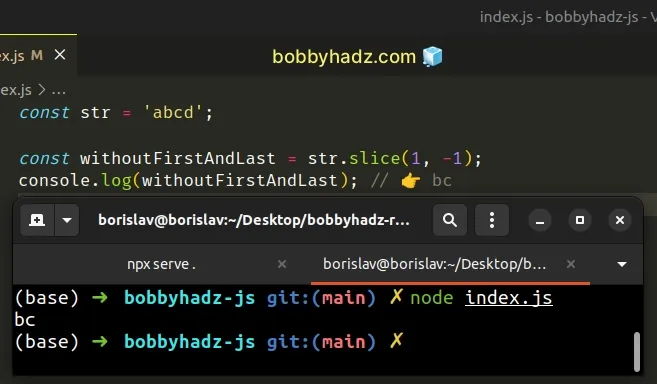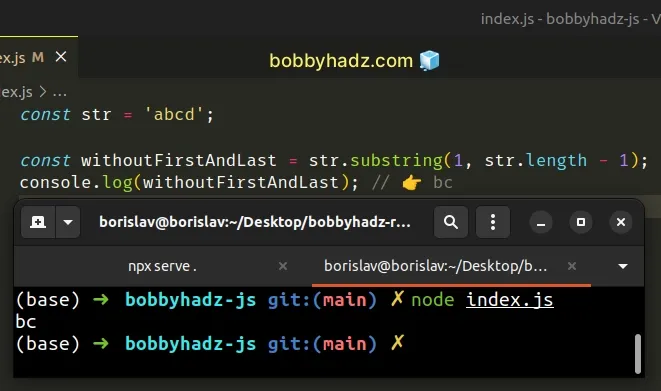Remove First and Last Characters from a String in JavaScript
Last updated: Mar 1, 2024
Reading time·2 min

# Remove First and Last Characters from a String in JavaScript
To remove the first and last characters from a string, call the slice()
method, passing it 1 and -1 as parameters.
The String.slice() method will return a copy of the original string with the
first and last characters removed.
const str = 'abcd'; const withoutFirstAndLast = str.slice(1, -1); console.log(withoutFirstAndLast); // 👉️ bc

We passed the following arguments to the String.slice() method:
- start index - the index (zero-based) at which we start extraction.
- end index - extract characters up to, but not including this index. A
negative index of
-1means "go up to, but not including the last character in the string".
-1 and str.length - 1 is the same. We instruct the slice method to go up to, but not including the last character in the string.The String.slice() method doesn't mutate the original string, it returns a new
string. Strings are immutable in JavaScript.
Calling the slice() method on an empty string doesn't throw an error, it
returns an empty string.
const str = ''; const withoutFirstAndLast = str.slice(1, -1); console.log(withoutFirstAndLast); // 👉️ ""
# Remove First and Last Characters from a String using String.substring()
Alternatively, you can use the String.substring() method.
const str = 'abcd'; const withoutFirstAndLast = str.substring(1, str.length - 1); console.log(withoutFirstAndLast); // 👉️ bc

We used the String.substring() method to achieve the same result.
The String.substring() method returns a slice of the string from the start index to the excluding end index.
The method takes the following parameters:
| Name | Description |
|---|---|
| start index | The index of the first character to include in the returned substring |
| end index | The index of the first character to exclude from the returned substring |
If no end index is specified the slice goes to the end of the string.
There are a couple of
differences
between the String.substring() and the String.slice() methods:
- The
substring()method swaps its start and end index if the start index is greater than the end index. Theslice()method returns an empty string in this case.
const str = 'bobby'; console.log(str.substring(3, 0)); // 👉️ bob console.log(str.slice(3, 0)); // 👉️ ''
- If either of both arguments passed to
substring()are negative, they are treated as if they were0.
const str = 'bobby'; console.log(str.substring(-3)); // 👉️ bobby console.log(str.slice(-3)); // 👉️ bby
When given a negative index, the slice() method counts backward from the end
of the string to find the indexes.
My personal preference is to use the String.slice() method because it's more
intuitive than String.substring() in many different scenarios.
# Additional Resources
You can learn more about the related topics by checking out the following tutorials:
- Replace/Remove characters that Don't match Regex in JS
- Remove everything after a specific Character in JavaScript
- Remove the first N characters from a String in JavaScript
- Remove the last N Characters from a String in JavaScript
- Remove all non-alphanumeric Characters from a String in JS
- Remove special Characters from a String in JavaScript

